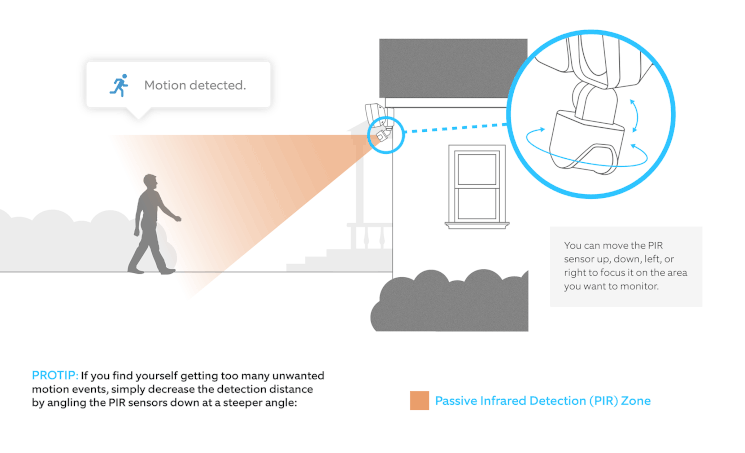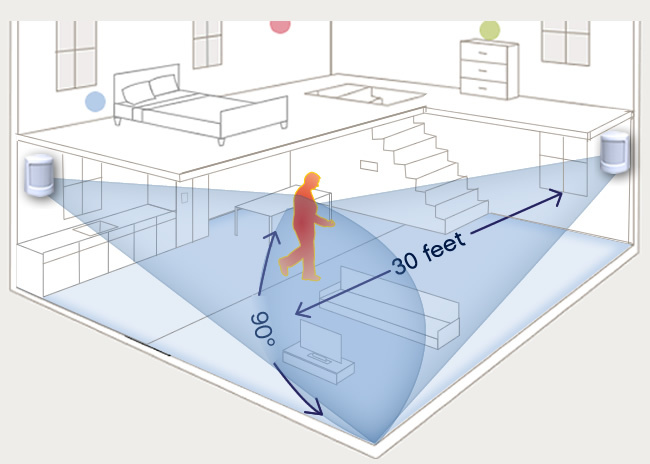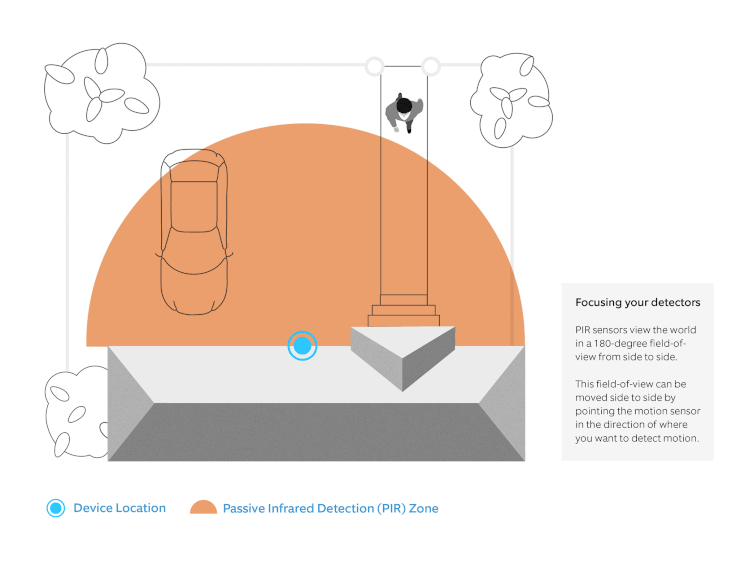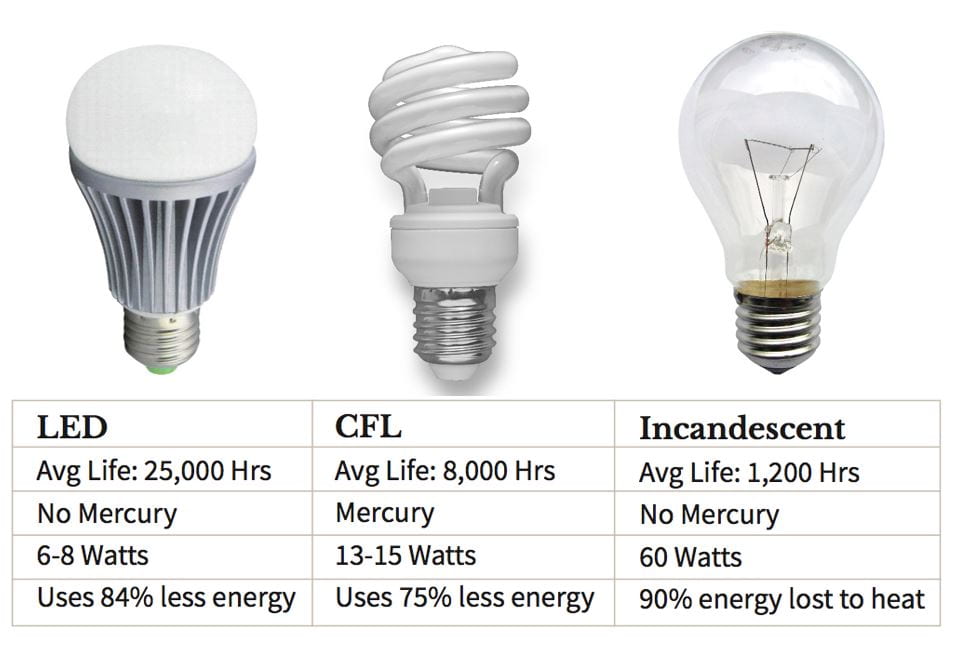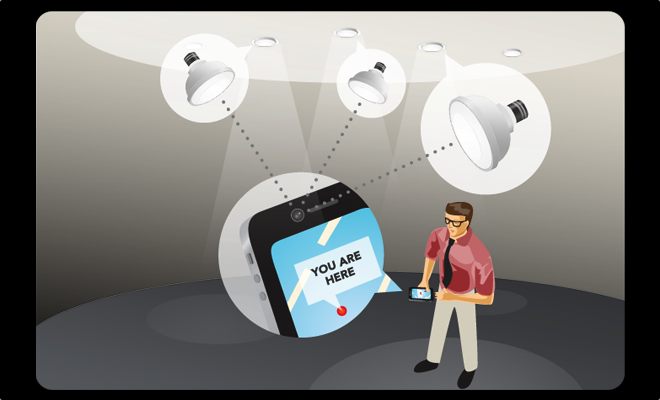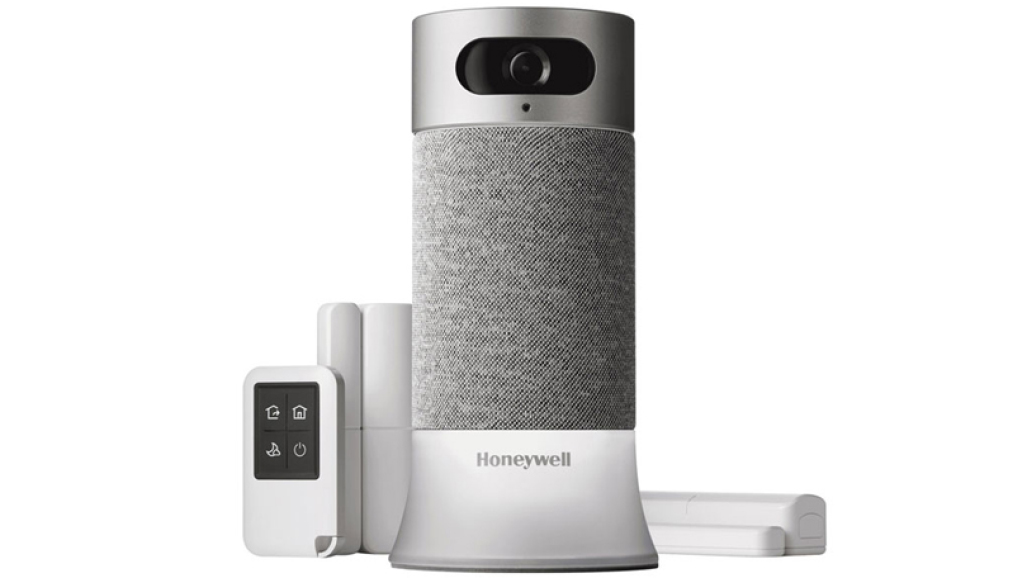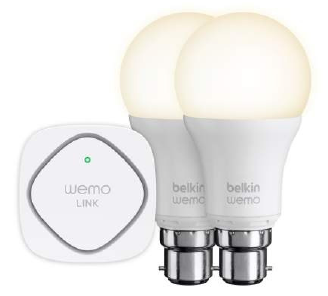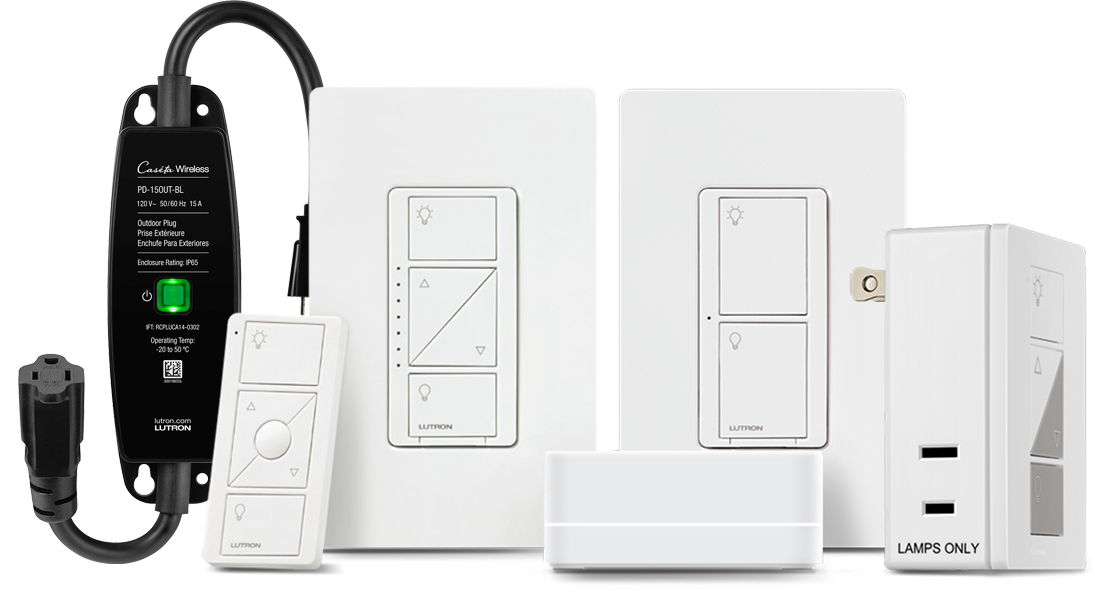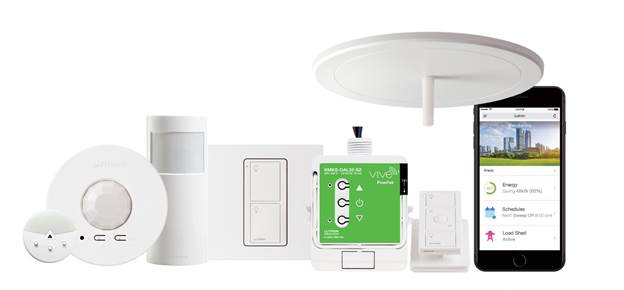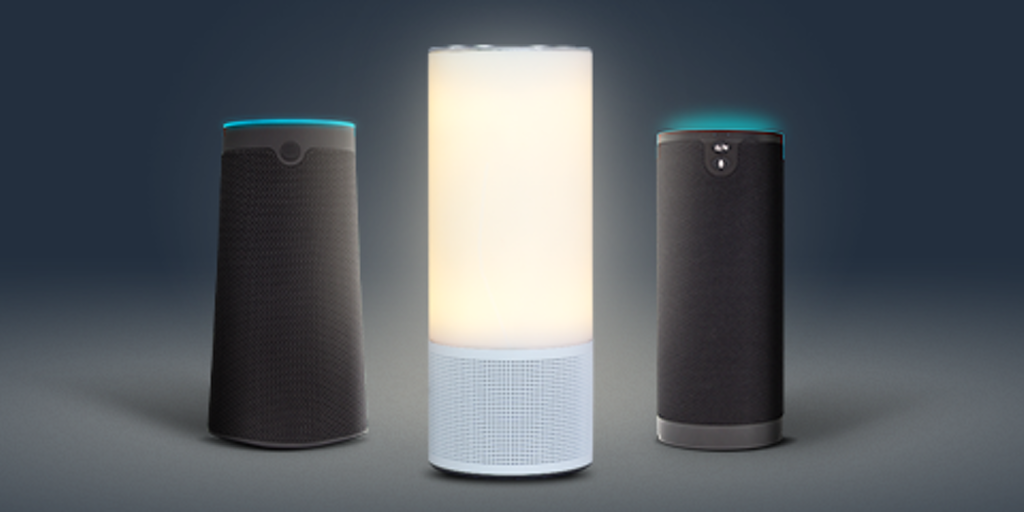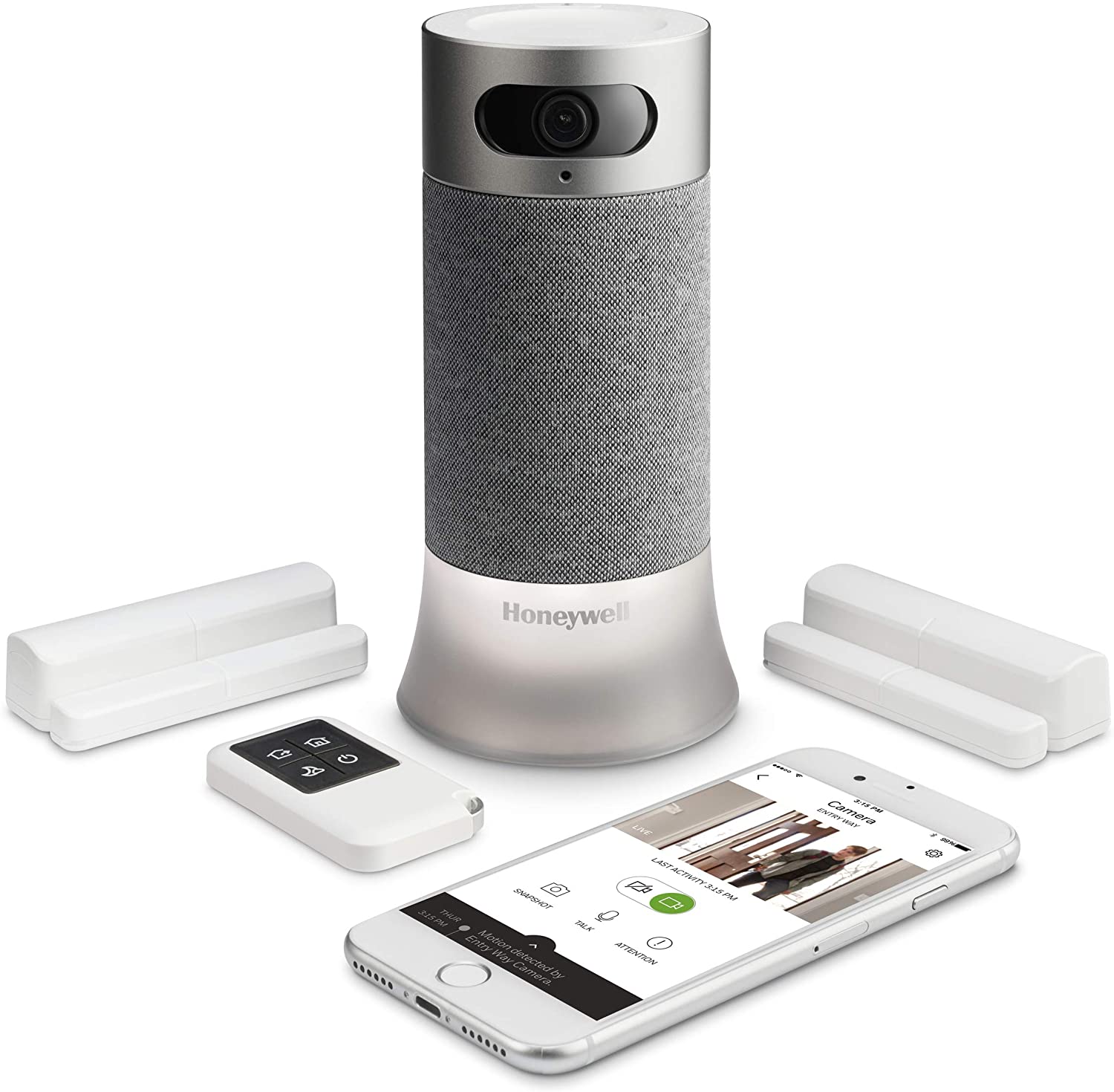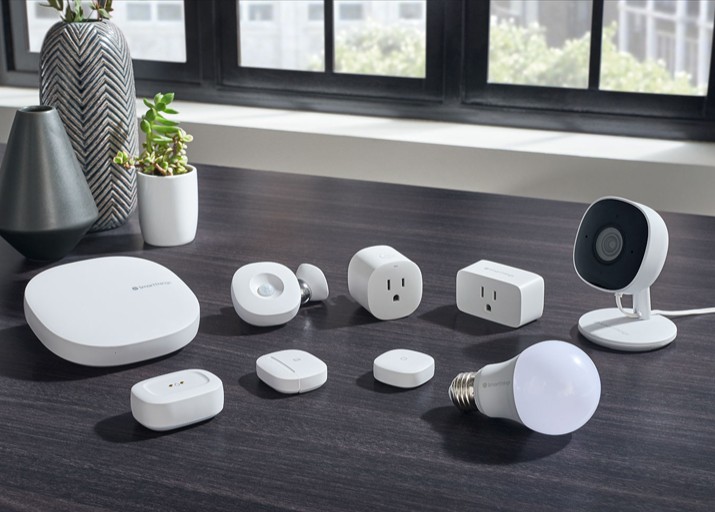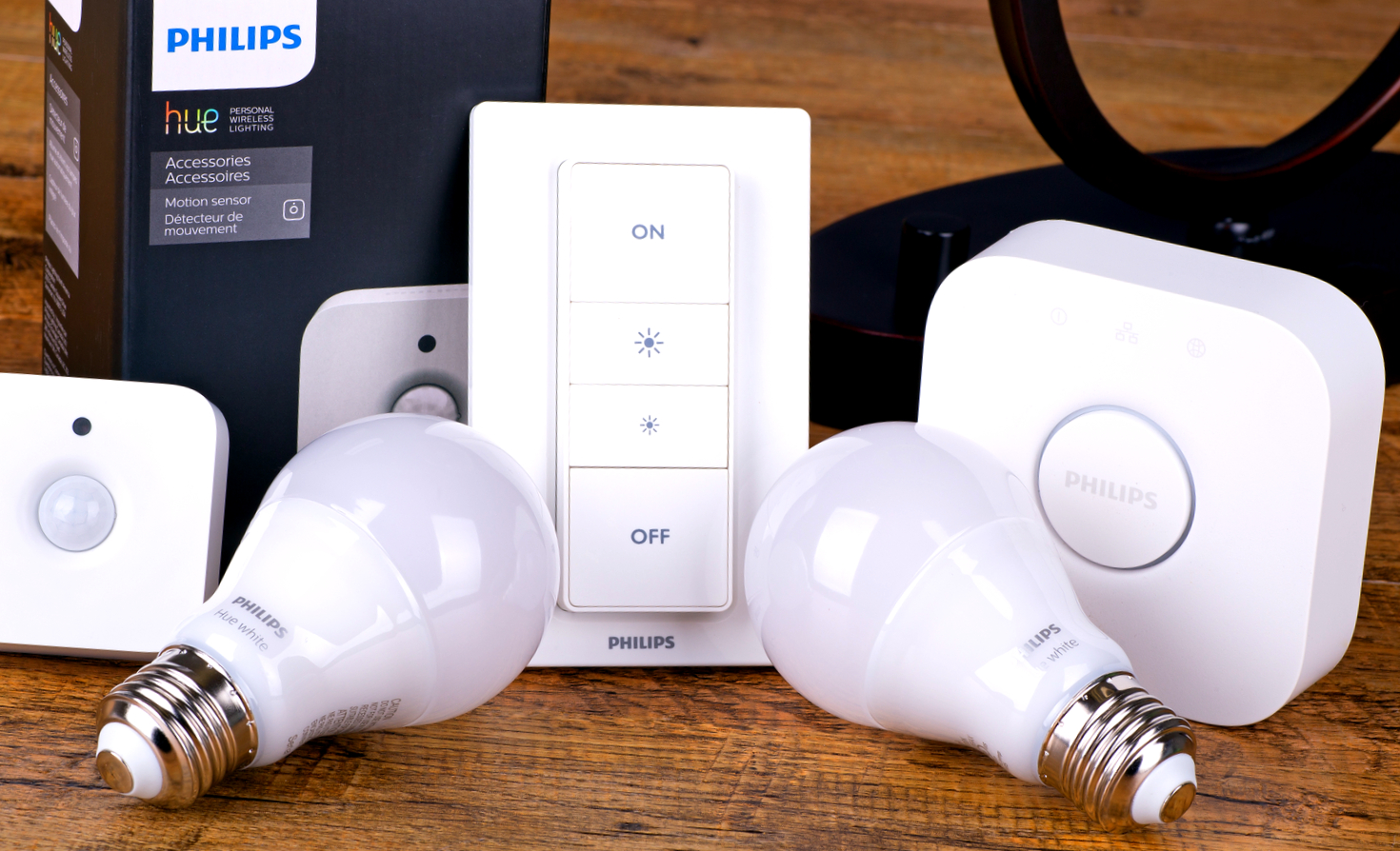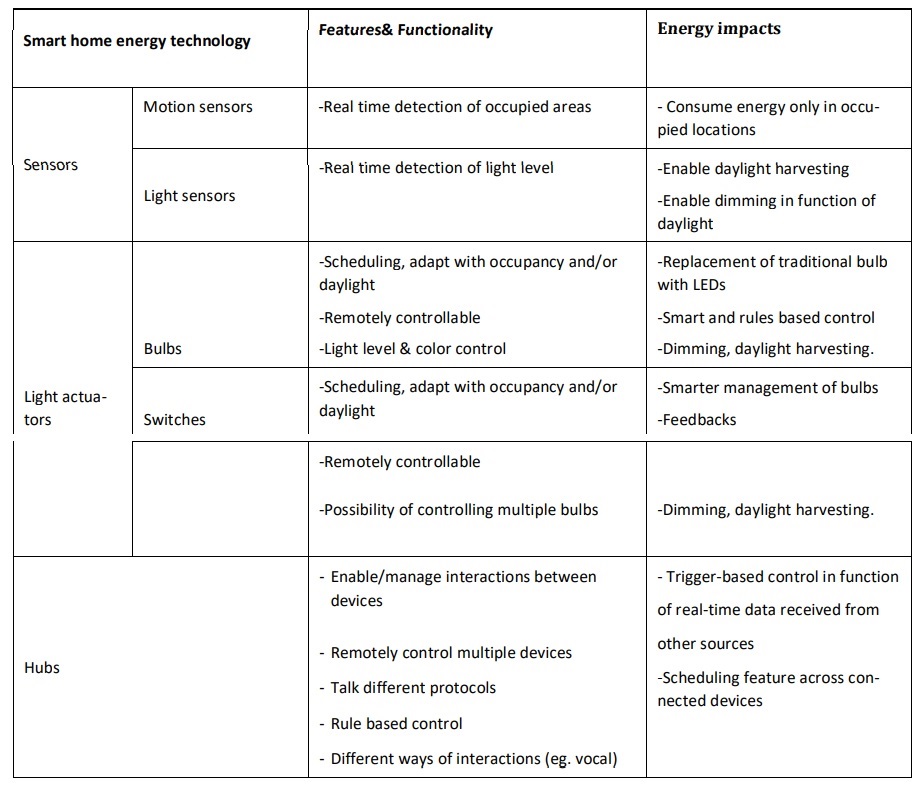روشنایی هوشمند
در یک ساختمان، روشنایی 20 تا 60 درصد از کل مصرف انرژی الکتریکی را شامل می شود. برای روشن و خاموش کردن لامپ با کلید، گاهی اوقات افراد هنگام خروج از اتاق فراموش می کنند که آن را خاموش کنند. جایی که لامپها بر اساس نیاز کار نمی کنند، این امر منجر به عدم استفاده بهینه انرژی و تحمیل هزینه اضافی می شود. برای غلبه بر این مشکل ، یک سیستم روشنایی هوشمند با استفاده از مفهوم اینترنت اشیاء طراحی می شود تا بتوان چراغ ها را از راه دور کنترل و نظارت کرد.
این مقاله به بررسی تأثیرات اقتصادی، اجتماعی و محیطی اتخاذ معماری های مختلف روشنایی هوشمند برای اتوماسیون خانه در دو منطقه جغرافیایی و مقرراتی می پردازد. نورپردازی مقدار قابل توجهی انرژی مصرف می کند و دستگاه هایی برای ارائه روشنایی هوشمند جزء پرفروش ترین دستگاه های خانه هوشمند هستند. از آنجا که راه حل های تجاری با ویژگی های متفاوتی ارائه می شوند، ما از طریق این مقاله تأثیر هر یک از ویژگی های مرتبط با انرژی را ارزیابی می کنیم و روشهایی را که سهم بیشتری در صرفه جویی انرژی دارند، ارائه می دهیم. این مطالعه با بررسی پیشرفته ترین راه حل های تجاری تجاری کنترل روشنایی مبتنی بر فناوری اطلاعات و ارتباطات آغاز می شودکه امکان استخراج ویژگی های مرتبط با انرژی را فراهم کرد. بر اساس نتایج این مطالعه، ما سناریوهای شبیه سازی و معیارهای ارزیابی را برای ارزیابی تأثیر کم نور، برداشت نور روز، زمان بندی و تشخیص حرکت انتخاب کردیم.
معرفی سیستم روشنایی هوشمند
بازار ساختمانهای هوشمند با افزایش مداوم محصولات و خدمات جدید در حال رونق است. رقابت در این حوزه بین سهامداران فناوری اطلاعات و ارتباطات (ICT) تهاجمی می شود و شرکت ها دائماً از پتانسیل محصولات خود برای صرفه جویی در انرژی ادعا می کنند.
در حالی که بسیاری به فناوری های خانه هوشمند در ارائه راهکارهای مدیریت انرژی پایدار اعتماد دارند، دیگران هنوز در مورد مزایای واقعی این فناوری ها شک دارند. این مقاله به بررسی (کیفی و کمی) استفاده از فناوری های هوشمند در مدیریت انرژی ساختمانها در حالی که بر سیستمهای کنترل روشنایی و سهم آنها در صرفه جویی در انرژی می پردازد. این مطالعه به برآورد کاهش مصرف انرژی به دلیل سیستم های کنترل نور محدود نمی شود، بلکه تأثیر هر یک از ویژگی های ارائه شده توسط این فناوری ها را نیز بررسی می کند. افزایش جزئیات مطالعه درک عمیق تری از آنچه ممکن است پتانسیل صرفه جویی در انرژی را افزایش دهد، ارائه می دهد. نتایج این مطالعه به محققان، مصرف کنندگان و تولیدکنندگان کمک می کند تا توانایی سیستم های کنترل را در صرفه جویی در انرژی بهبود بخشند.
برخلاف اکثر مطالعات موجود، مطالعه شبیه سازی مقایسه ای ما تنها به اندازه گیری انرژی محدود نمی شود، بلکه مشکل را از جنبه های مختلف از جمله اقتصاد (تجزیه و تحلیل هزینه و فایده)، محیط زیست (کاهش انتشار گازها و صرفه جویی در منابع) و تأثیرات اجتماعی ( افزایش درآمد واگذاری). ما این معیارها را برای خوانندگان بیشتر از میزان صرفه جویی شده انرژی بیان می کنیم. به عنوان مثال “صرفه جویی بیش از 10000 یورو در طول ده سال، صرفه جویی در محیط زیست 2000 کیلوگرم CO2 سالانه با بازپرداخت 6 ماهه” ، درک بهتری از بیان تأثیر چنین راهکار هایی نسبت به مقدار صرفه جویی “5000 کیلووات ساعت” را به دنبال دارد.
در این مطالعه دو شهر با دو ویژگی آب و هوایی متفاوت و محیط های نظارتی در مورد قیمت انرژی که بر مصرف انرژی تأثیر می گذارد مورد بررسی قرار می گیرد: الجزایر در مقابل اشتوتگارت. الجزایر روزهای آفتابی بیشتری دارد (به ویژه در زمستان) ، که این امر پتانسیل برداشت نور روز را افزایش می دهد. آلمان دارای قیمت انرژی بالاتری است که مزایای اقتصادی صرفه جویی در انرژی در اشتوتگارت را افزایش می دهد. تمرکز مطالعه بر کنترل نور است که پس از HVAC (تهویه گرمایش و تهویه مطبوع) دومین سیستم مصرف کننده انرژی در ساختمانهای امروزی است. علاوه بر این، این سیستم تأثیر قابل توجهی بر راحتی و بهره وری ساکنین ساختمانها دارد. لامپ های هوشمند یکی از فناوری های کم هزینه و آسان برای استقرار و یکی از سریع ترین محصولات در حال رشد در بازارهای اینترنت اشیا (IoT) هستند. انتظار می رود در سالهای آینده رشد مداوم داشته باشد و تا سال 2020 در دهها میلیون خانوار نفوذ کند. بررسی حدود 300 دستگاه فناوری اطلاعات و ارتباطات که توسط مصرف کنندگان پذیرفته شده است نشان می دهد که راه حل های روشنایی هوشمند یکی از پرطرفدارترین ها هستند، که انگیزه ای برای انتخاب این مطالعه است.
محصولات کنترل روشنایی در بازار مورد بررسی قرار می گیرند. بر این اساس، ما ویژگی هایی را که بیشترین صرفه جویی در انرژی را از مواردی که باعث بهبود راحتی و امنیت می شوند، استخراج می کنیم. این ویژگی ها عبارتند از: جمع آوری نور روز، کنترل میزان روشنایی، زمان بندی و تشخیص حرکت.
کار مرتبط در زمینه هوشمند سازی روشنایی
با توجه به اهمیت مدیریت انرژی در ساختمانها و پتانسیل آن، این امر برای صرفه جویی در انرژی ارائه می شود، بسیاری از تحقیقات و توسعه به بهینه سازی مصرف انرژی در ساختمانهای هوشمند اختصاص یافته است. محققان و مهندسان استراتژی های کنترلی را پیشنهاد کردند که محیط هایی را ایجاد می کند که بتوانند نیازهای راحتی سرنشینان خود را برآورده کرده و در عین حال مصرف انرژی را به حداقل برسانند. سیستم های روشنایی و حرارتی با توجه به ردپای انرژی بالا و تاثیر زیاد آنها بر راحتی و بهره وری بیشتر مورد توجه قرار می گیرند. جویدن و همکاران مروری بر راه حل های ارائه شده برای بهینه سازی روشنایی ارائه شده است. آنها متداول ترین روشها برای کاهش مصرف انرژی، مانند تشخیص اشغال اتاقها و برداشت نور روز را شرح دادند. آنها پتانسیل راه حل های مختلف را با درصد صرفه جویی در انرژی اندازه گیری کردند. این مقاله همچنین راه حل هایی را برای تلاش برای بهینه سازی جلوه های غیر بصری نور، مانند کاهش سطح استرس انسان و افزایش سلامت و عملکرد کار، مورد بحث قرار می دهد. علاوه بر بهینه سازی انرژی و روشنایی، جنبه های فنی مانند اتصال بین اجزای مختلف سیستم و ارتباطات نور مرئی (VLC) مورد بررسی قرار گرفته است.
راه حلهای صرفه جویی در انرژی خانگی معمولاً مبتنی بر تشخیص اشغال هستند، که این امر باعث تحریک محققان در ارائه راه حل هایی با تمرکز بر تشخیص دقیق اشغال اتاق می شود. اطلاعات اشغال از تشخیص دوتایی (سرنشین در مقابل خالی) تا سرشماری افراد در زمان واقعی متفاوت است. کنترل روشنایی مبتنی بر اشغال در فضاهای اداری با طرح باز. به دلیل اهمیت اطلاعات مربوط به اشغال بودن، سایر محققان بر استقرار سنسورهای حرکت در ساختمان ها تمرکز کردند. پیشنهاد کرد که یک مرحله یادگیری قبل از استقرار برای تشخیص بیشترین نقاط مورد استفاده در ساختمان اختصاص داده شود و سپس استقرار حسگرهای حرکت در این نقاط متمرکز شود.
شکاف های میدان دید سنسورهای حرکت مادون قرمز منفعل (PIR) (که حفره های حسگر نامیده می شوند) را در نظر گرفت. در داخل این حفره های حسگر، سنسور قادر به تشخیص حرکات رخ داده نیست، که منجر به اطلاعات کاذب می شود. نویسندگان راه حلی برای همپوشانی مناطق سنجش به روشی برای پوشش این شکاف ها و افزایش دقت ارائه کردند.
با وجود پیشرفته ترین فن آوری های موجود در راه حل های ساختمان هوشمند، این حوزه هنوز به بلوغ نمی رسد. بین تحقیقات کنونی و سیستم های تجاری موجود شکاف وجود دارد. این شکاف باعث می شود وعده های ارائه شده توسط رویکردهای پیشرفته در زمینه کاهش انرژی مصرفی با واقعیتی که در راه حل های تجاری ارائه می شود متفاوت باشد. راه حل های تجاری بر زیبایی و کنترل از راه دور با استفاده از رابط های برنامه تلفن همراه تأکید می کند تا به کاربران اجازه دهد پارامترهای خروجی نور را تنظیم کرده و به عنوان اطلاعات ورودی الگوریتم های کنترل خود به این اطلاعات و داده های ابری تکیه کنند. ویژگی های مختلف ارائه شده توسط سیستم روشنایی هوشمند راه حل های تجاری را مورد بررسی قرار می دهد و بر این تفاوت در مقایسه با ادبیات موجود تأکید می کند. اثری که به طور کامل به راه حل های تجاری اختصاص داده شده است، جایی که نویسندگان پایگاه داده ای از بیش از 300 دستگاه را جمع آوری کرده و آنها را در دسته بندی ها گروه بندی کردند. آنها برای هر دسته ویژگی های اصلی دستگاه های خانه هوشمند را مشخص کردند و توضیح دادند که چگونه این ویژگی ها می تواند مصرف انرژی را کاهش دهد. با وجود این که این مطالعه بسیاری از دستگاه ها را مورد تجزیه و تحلیل قرار داد، به مقایسه کیفی محدود می شود و نویسندگان هیچ مطالعه عددی برای برآورد تأثیر ویژگی های مختلف بر مصرف انرژی انجام نداده اند.
ساختمانهای هوشمند را از نظر مشتری با پرسیدن نظرات 29 شرکت کننده پس از زندگی در یک خانه هوشمند مجهز مورد مطالعه قرار داد. این مطالعه شامل تعرفه های متغیر انرژی، اندازه گیری هوشمند، لوازم هوشمند و اتوماسیون خانه بود. نتایج نشان می دهد که انگیزه های اصلی برای پذیرش شامل پس اندازهای پولی و ردپای محیط زیست است. از سوی دیگر، هزینه های زیاد، حریم خصوصی داده ها و پیچیدگی فنی دلایل اصلی امتناع است. دیدگاه نیاز به انجام تجزیه و تحلیل عددی در مورد مزایای فناوری های جدید را با کار حاضر به اشتراک می گذارد. نویسندگان تأثیر جایگزینی روشنایی سنتی با LED در دانشگاه پردیس را ارزیابی کردند. با این حال، محدوده به تأثیر تعویض لامپ با لامپ کارآمدتر (CFL در مقابل لامپ های LED) محدود می شود، بدون در نظر گرفتن ویژگی های ارائه شده توسط لامپ های متصل هوشمند، که در کار ما مورد توجه قرار گرفته است.
سیستم های روشنایی تجاری
این بخش به تشریح راه حل های تجاری شده برای سیستم های روشنایی هوشمند مدرن اختصاص دارد. دستگاه های ذکر شده در این بخش یا راه حل هایی برای سیستم های روشنایی هستند، مانند لامپ های هوشمند و سوئیچ ها یا برای اهداف عمومی تری طراحی شده اند، اما می توانند در سیستم های روشنایی هوشمند استفاده شوند. نمونه هایی از این دستگاه ها هاب ها و سنسورهای هوشمند هستند. در ارائه ما برای هر دسته، ما با برآورد ویژگی های مربوط به انرژی و غیر مرتبط با انرژی شروع می کنیم. ما در ادامه پروتکل های ارتباطی مورد استفاده و محدوده قیمت را مورد بحث قرار می دهیم، در حالی که یک لیست کامل از محصولات موجود در پکیج ارائه می دهیم.
دستگاه های کنترل روشنایی هوشمند
این دسته شامل لامپ های هوشمند و سوئیچ شده است که هدف کلی آنها همان لامپ ها و سوئیچ های سنتی است اما دارای ویژگی های اضافی در دو بخش بعدی است.
لامپ های هوشمند
در مقایسه با لامپ های سنتی، لامپ های هوشمند طیف گسترده ای از انتخاب ها را برای کنترل و تعامل ارائه می دهند. این ویژگیها هم باعث افزایش راحتی و هم صرفه جویی در انرژی می شوند. از منظر صرفه جویی در مصرف انرژی، لامپ های هوشمند به تایمرهای برنامه ریزی شده اجازه می دهد تا خودکار بیداری، خواب و زمانبندی را تنظیم کنند. برخی از لامپ ها از GPS برای تشخیص محل دقیق تلفن هوشمند کاربر استفاده می کنند و هنگامی که کاربر به مسافت مشخصی از خانه خود می رسد چراغ ها را به طور خودکار روشن یا خاموش می کند. بسته به سازگاری، برخی از لامپ ها را می توان با سایر وسایل خانه هوشمند مانند دوربین های امنیتی، ترموستات ترکیب کرد، که به آنها امکان می دهد از اطلاعات موجود در این دستگاه ها استفاده کرده و کنترل نور را بهینه کنند.
ویژگی های اصلی مربوط به راحتی که توسط لامپ های هوشمند ارائه می شود، قابلیت تغییر رنگ و کنترل از راه دور آنها است. رنگ بر فضای خانه تأثیر می گذارد: دمای رنگ بالا برای روشنایی دفتر مناسب است و به بیدار ماندن، تمرکز و کار کمک می کند در حالی که دمای رنگ پایین تابشی گرم برای آرامش ایجاد می کند. برخی از لامپ ها حتی می توانند با فیلم ها و برنامه های تلویزیونی خاصی همگام شوند. با این حال، ویژگی تغییر رنگ در همه لامپ های هوشمند موجود نیست بلکه فقط در لامپ های گران قیمت موجود است. یکی دیگر از ویژگی های افزایش راحتی، گزینه کنترل از راه دور دستگاه تلفن همراه است که به کاربر اجازه می دهد روشنایی هوشمند، رنگ یا هر دو را از هر مکان، حتی در خارج از خانه تنظیم کند.
کارایی لامپ های هوشمند هنگامی که بخشی از شبکه حسگرها و سایر دستگاه های هوشمند هستند افزایش می یابد. اطلاعات ارائه شده توسط سایر عناصر موجود در شبکه به آنها امکان می دهد از تغییرات زمان واقعی محیط مطلع شده و در نتیجه خروجی خود را با این تغییرات تطبیق دهند. برخی از لامپ ها شبکه مش خود را ایجاد می کنند که نیاز به وجود یک هاب برای ارتباط با سایر دستگاه ها و تلفن هوشمند کاربر دارد. این عمدتا به دلیل رایج ترین پروتکل روشنایی بی سیم، ZigBee است. LED های Philips Hue ،Osram Lightify LED ها، Belkin WeMo LED ها نمونه هایی از لامپ های هوشمند موجود در بازار هستند که با ZigBee ارتباط برقرار می کنند. از آنجا که تلفن های هوشمند عموماً با ZigBee فعال نیستند، اتصال بین دستگاه ها مورد نیاز است. از طرف دیگر، لامپ هایی مانند Lifx A19 می توانند مستقیماً به شبکه WiFi متصل شوند. برخی از تولید کنندگان از بلوتوث استفاده کردند تا لامپ های خود را مستقیماً با دستگاه تلفن همراه متصل کند، مانند لامپ های تولید شده توسط GE.
لامپ ها نیازی به پل یا اتصال به شبکه خانگی ندارند، اما نمی توان آنها را در خارج از محدوده بلوتوث، به عنوان مثال، در خارج از خانه کنترل کرد. استفاده از بلندگوی بی سیم مانند Amazon Echo یا Google Home به عنوان مرکز کنترل نور صوتی را امکان پذیر می کند. با این حال، این ویژگی توسط برخی از برنامه های تلفن همراه لامپ نیز ارائه می شود.
بسته به ویژگی های ارائه شده، قیمت هر لامپ هوشمند از 151 یورو تا 70 یورو متغیر است. اکثر لامپهای موجود لامپهای A شکل با پایه های پیچ دار به شکل E هستند. که سازگاری آنها را با سایر انواع وسایل، به عنوان مثال، لوستر محدود می کند.
سوئیچ های هوشمند
سوئیچ های دیواری هوشمند به جای هوشمند سازی لامپ، به طور خودکار کلیدهای روشن/خاموش دیواری را امکان پذیر می کند. جایگزینی یک سوئیچ تک سیم کشی چند لامپ یا اتوماسیون لامپ های کوچک پیچ دار پایه ای که لامپ های هوشمند برای آنها در دسترس نیست، مفید است. با پیشنهاد تایمر، کاهش نور هوشمند و امکان بهینه سازی کارایی روشنایی در ترکیب با سنسورها، سوئیچ های هوشمند دارای ویژگی های صرفه جویی در انرژی مشابه با لامپ های هوشمند هستند.
سوئیچ های هوشمند پیچیده تر و گران تر، صفحه نمایش لمسی رنگی، بلندگوها و میکروفون های داخلی را برای عملکرد اینترکام ارائه می دهند با این حال، این سوئیچ ها با توجه به قیمت بالایی که دارند، در حالی که گزینه های مشابه یا محدودی را در مقایسه با لامپ های هوشمند ارائه می دهند، به موفقیت مورد نظر سازندگان خود نمی رسند.
مشابه لامپ های متصل، اکثر سوئیچ های هوشمند از طریق WiFi (به عنوان مثال، سوئیچ Belkin WeMo) یا ZigBee (به عنوان مثال، سوئیچ هوشمند GE دیواری) متصل می شوند. سوئیچ هایی که توسط ZigBee ارتباط برقرار می کنند برای اتصال با تلفن هوشمند به یک هاب نیاز دارند.
Lutron، یک شرکت تخصصی در زمینه روشنایی هوشمند، از سیگنال اختصاصی Lutron خود استفاده می کند.
قیمت سوئیچ های هوشمند حدود 50 یورو است که در مقایسه با لامپ های هوشمند آنها را انتخاب گرانتری می کند. افزایش سیستم روشنایی خانه با کلیدهای هوشمند به اندازه لامپ های هوشمند مقرون به صرفه نیست مگر اینکه از آنها برای کنترل چندین لامپ استفاده شود. استفاده از سوئیچ های هوشمند ممکن است صرفه جویی در مصرف انرژی کمتری را در مقایسه با لامپ ها حتی با استفاده از همان استراتژی کنترلی در مواردی که لامپ های مورد استفاده توسط سوئیچ ها کارآمد نیستند، به عنوان مثال، استفاده از سوئیچ هوشمند برای کنترل لامپ رشته ای 60 وات. از سوی دیگر، لامپ های هوشمند همه لامپ های کم مصرف LED با توان کمتر از 11 وات هستند. به همه این دلایل، ما در مطالعه شبیه سازی خود لامپ های هوشمند را در نظر می گیریم.
هاب هوشمند و بلندگوهای بی سیم
Bluetooth LE ،Lutron Clear Connect ،WiFi ،Z-Wave و ZigBee پروتکل های ارتباطی هستند که در راه حل تجاری سازی اتوماسیون خانگی گنجانده شده اند. نقش یک مرکز اتوماسیون خانگی این است که دستگاه های متصل را متحد کرده و آنها را با یکدیگر صحبت کند. هاب ها همچنین با گروه بندی همه آنها در یک برنامه هوشمندانه، جذاب و بصری به جای استفاده از رابط اختصاصی برای هر دستگاه، کنترل این دستگاه ها را آسان می کنند. قیمت هاب هوشمند از 49 یورو شروع می شود و ممکن است تا 350 یورو برای کسانی که از استانداردهای زیادی پشتیبانی می کنند و دارای امنیت بالاتری هستند، دارای رابط کاربری و سخت افزار گسترده است. پشتیبانی از IFTTT (If This Then That) نیز مفید است، زیرا روشهای مختلفی را برای پیکربندی و راه اندازی دستگاه های متصل ارائه می دهد. بلندگوهای بی سیم مانند Google home و Amazon alexa به کاربر اجازه می دهد دستگاه های سازگار خود را با دستورات صوتی کنترل کند.
تشخیص زمان واقعی با استفاده از سنسورها: سنسور حرکت و نور
اگر خانه بتواند بسته به پویایی محیط، اجزای کنترل شده (مانند سیستم روشنایی) را تنظیم کند، هوشمندتر است. حسگرها چشمانی هستند که اجازه می دهند داخل ساختمان “ببینند” و به تغییرات واکنش نشان دهند. بازار مجموعه ای کامل از سنسورها را برای خانه های هوشمند با اهداف مختلف اعم از انرژی، راحتی و امنیت ارائه می دهد. ما ممکن است به آشکارسازهای نشت و یخ از Roost و Honeywell، سنسورهای دمای اتاق Eco bee و اشغال و سنسورهای آب و هوا اشاره کنیم. با این حال، در این بخش، ما بر مواردی که بر عملکرد نور هوشمند تأثیر می گذارد تمرکز می کنیم: حسگرهای اشغال و نور. در خانه های هوشمند، سنسورهای باز شدن درها و پنجره ها محبوب هستند. سنسورهای باز/بسته شدن را می توان به در یا پنجره متصل کرد و در صورت باز شدن پنجره یا درب به کاربر هشدار می دهد. این سنسورها برای امنیت استفاده می شوند، اما در کنترل نور نیز کاربرد دارند و ممکن است برای روشن شدن چراغ ها در صورت ورود و خاموش شدن کاربر پس از مدتی بدون حرکت استفاده شوند.
رایج ترین سنسورهای حرکت، سنسور PIR (مادون قرمز منفعل) است. آنها می توانند اجسامی را که از نظر فیزیکی انرژی (گرما) ساطع می کنند، در حین عبور از محدوده حساسیت خود تشخیص دهند. انواع دیگر سنسورهای حرکت شامل امواج میکرو و اولتراسونیک و گاهی ترکیبی از انواع مختلف است. سنسورها ممکن است به صورت جداگانه یا به عنوان بخشی از مجموعه خریداری شوند، به عنوان مثال، Ring و حسگر حرکت Samsung Smartthings. اکثر سنسورهای حرکتی که بررسی کردیم از پروتکل Z-Wave برای برقراری ارتباط استفاده می کنند. پوشش حرکت و حساسیت از عوامل حیاتی برای کارایی حسگرها هستند. برخی از سنسورهای حرکت، مانند سنسور حرکت Everspring Compact Z-Wave، دارای حساسیت قابل تنظیم هستند. بسته به فضای تحت نظارت، داشتن محدوده قابل تنظیم می تواند بسیار مفید باشد. برخی نیز دارای ویژگی ای به نام “ایمنی حیوان خانگی” هستند که حرکتی را از حداکثر اندازه مشخص شده تشخیص نمی دهد. به عنوان مثال،سنسور تشخیص حرکت Ecolink Z-Wave Plus در برابر حرکت حیوانات خانگی کمتر از 25 کیلوگرم مصون است. کاربر باید در قرار دادن سنسورهای خود دقیق باشد تا از هشدارهای مثبت و منفی کاذب اجتناب کند.
در نهایت، برخی از سنسورهای حرکت برای کارهای خاصی در نظر گرفته شده اند. به عنوان مثال، سنسور حرکت Philips Hue [37] منحصر به فرد برای فعال کردن چراغ ها در هنگام تشخیص حرکت طراحی شده است. سنسورهای نور با توجه به سطح نور محیط داخلی می توانند خاموش و روشن شوند، اما کمتر مورد استفاده قرار می گیرند و کمتر در بازار موجود هستند. جدول 1 به طور خلاصه لوازم خانگی هوشمند مربوط به کنترل سیستم روشنایی (از آنها در کنترل سیستم های حرارتی نیز استفاده می شود)، ویژگی های پیشنهادی آنها و اینکه چگونه این ویژگی ها می توانند در صرفه جویی در انرژی کمک کنند، ارائه شده است.
نتیجه
ساختمانها فن آوریهای مدیریت انرژی دارای پتانسیل فنی برای ارائه مزایای صرفه جویی در انرژی برای کاربران و خدمات شهری هستند. این محصولات با استفاده از اطلاعات زمینه ای مانند اشغال بودن و نور روز، تقاضا را کاهش می دهند و می توانند با ارسال اعلان ها و نمایش مصرف انرژی، از کاربران در کاهش یا تغییر بارها پشتیبانی کنند. محصولات پیشنهادی در حال حاضر در بازار، از هر دو دستگاه خانه های هوشمند مرتبط با انرژی و غیر انرژی استفاده می کنند. این ترکیب ارزش فناوری خانه های هوشمند را برای مصرف کنندگان ارائه می دهد و مدیریت انرژی خانه را در عین افزایش امنیت و راحتی، امکان پذیر می کند، به عنوان مثال، قادر به کاهش بار سبک هنگام کنترل صوتی آن است.
این تحقیق بینش مدیریت انرژی را از هر یک از رایج ترین ویژگی های مرتبط با انرژی برای کنترل روشنایی ارائه کرد. بر خلاف مطالعات موجود، مطالعه ما اولین موردی است که به تجزیه و تحلیل دقیق تر انتخاب های فناوری پرداخته است. ما تجزیه و تحلیل را که به طور کلاسیک بر کاهش انرژی متمرکز است به ملاحظات اقتصادی ، زیست محیطی و اجتماعی بزرگ می کنیم. تفکیک ویژگی ها به شما امکان می دهد عملکردهای انرژی و غیر انرژی را از هم جدا کنید و نشان می دهد که چقدر در صرفه جویی در انرژی نقش دارند. نتیجه نشان داده است که فناوری های خانه های هوشمند مزایای مختلفی را به همراه دارد ، اما بسته به مشخصات کاربران، هزینه انرژی و منطقه جغرافیایی، میزان انرژی ذخیره شده برای هر ویژگی تغییر می کند. به عنوان مثال، کم نور شدن و جمع آوری نور روز برای خانواده هایی که اعضای آنها در طول روز غایب هستند، مفیدتر نیست و زمان بندی می تواند یک راه حل کارآمد و کم هزینه برای خانواده هایی با دوره های معمول اشغال و خالی باشد. در حالی که تولیدکنندگان و دولتها به شدت از مزایای احتمالی صرفه جویی در مصرف انرژی استفاده می کنند، مطالعه ما نشان می دهد که نگرانی های اقتصادی و زیست محیطی می تواند به عنوان یک انگیزه قوی برای مشارکت در اتوماسیون ساختمان عمل کند.
از آنجا که مهمترین عامل زمان کار است، که به شدت به کاربر مربوط است، مفید است که در دستگاههای تجاری دارای قابلیت نظارت و پیگیری دقیق رفتار کاربران و سپس بر این اساس باشد. فعال سازی بهینه اتصال دستگاه های سنجش با هوش مصنوعی (AI) دقت تشخیص را افزایش داده و منجر به افزایش صرفه جویی در انرژی می شود. در حالی که محصولات پیشرفته چنین راه حل هایی را ارائه می دهند، اما در مقایسه با دیگر سیستم های خانه هوشمند مانند ترموستات ، دوربین مداربسته امنیتی ، بلندگوهای بی سیم و غیره در دستگاه های روشنایی تجاری کمتر حضور دارند. رفتارها نسبت به عادات دوستدار محیط زیست از طریق خدمات تشویقی مبتنی بر فناوری های پیشرفته مانند هوش مصنوعی (AI)، اینترنت اشیا، ارتباطات بی سیم و شبکه، که به تغییر اتوماسیون فعلی ساختمان به سمت ساختمان های دیجیتالی و نرم افزاری کمک می کند.
سوالات متداول درباره سیستم روشنایی هوشمند
سیستم روشنایی هوشمند در صرفه جویی در هزینه ها موثر است؟
پاسخ به این سوال قطعا مثبت است. این سیستم هوشمند می تواند به کامل ترین شکل هزینه های ناشی از مصرف انرژی و روشنایی را مدیریت کرده و در بهینه ترین حالت ممکن نگه دارد.
هدف از هوشمند سازی سیستم روشنایی ساختمان چیست؟
به کمک این سیستم شما قادر خواهید بود تنها در زمان های مورد نیاز از روشنایی استفاده کنید و به لطف سنسورهای دقیق این سیستم، ضمن جذابیتی که در ساختمان شما ایجاد می شود، هزینه ها نیز به طور محسوس کاهش پیدا می کند.
رایج ترین پروتکل اجرای سیستم روشنایی هوشمند کدام است؟
اگرچه همه پروتکل ها برای این بخش از هوشمند سازی، برنامه ای مدون دارند، اما به لطف پروتکل Z-Wave می توان این ساختار را به شکلی مطلوب اجرایی نمود.


